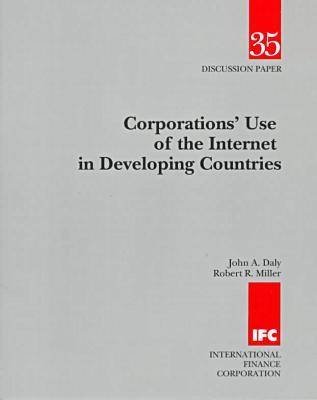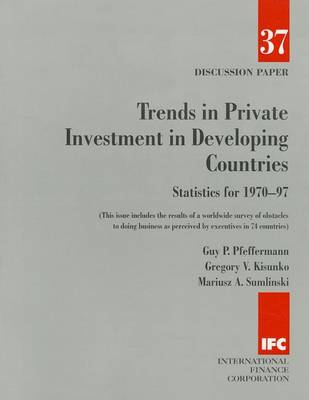IFC Discussion Paper
3 primary works • 5 total works
Book 35
Corporations' Use of the Internet in Developing Countries
by International Finance Corporation
Published 20 July 1998
This study uses a survey technique to explore corporate Internet use in developing countries. The survey includes both manufacturing and financial companies and provides an interesting picture of how firms in the developing world are beginning to utilize this new technology in ways broadly similar to companies in more industrialized countries.
Book 37
'For the 47 countries covered, 1997 was a record year for private investment, while public investment declined to its lowest level since 1975.' This is the tenth annual edition of 'Trends in Private Investment in Developing Countries'. It pulls together information provided by national organizations, World Bank and IMF economists in order to estimate levels of private investment. For the first time, China has been included in this series. The first part of this volume documents trends in private and public fixed investment. The second part presents country-specific results of a 1996/97 worldwide survey of business executives. The discussion focuses on obstacles to doing business in each of the 74 countries covered (including industrial economies) and their relationship to levels of private investment. A few factors emerge as being of particular importance to private investment decisions: the real exchange rate, the rule of law, predictability of judiciary systems, and the extent to which financing is available to enterprises.
Book 38
Time to Rethink Privatization in Transition Economies?
by International Finance Corporation
Published 22 June 1999
'It is now universally acknowledged that ownership matters; that private ownership in and of itself is a major determinant of good performance in firms ... Decent economic policy and well-functioning legal and administrative institutions ... matter greatly as well.' This paper looks at what happens when the shift to private ownership gets far out in front of the effort to build the institutional underpinnings of a capitalist economy. The emphasis is on what went wrong and why and what, if anything, can be done to be correct it. Proposals include renationalization and/or postponement of further privatization, both to be accompanied by measures to strengthen the managerial capacities of the state. Neither approach seems likely to produce short-term improvements. The regrettable fact is that governments that botch privatization are equally likely to botch the management of state-owned firms. In a number of Central European transition countries, privatization is living up to expectations; and there is no need for such measures. For institutionally-weak countries, the less dramatic but reasonable short-term course of action is to push ahead more slowly with case- by-case and tender privatization in cooperation with the international assistance community in hopes of producing some success stories that will lead by example.
No.31.
Trends in Private Investment in Developing Countries
by Stephen S Everhart and Mariusz A Sumlinski
Published 1 February 1997
The ninth edition of 'Trends in Private Investment in Developing Countries' provides private and public investment data through 1996. This year's edition includes information about levels of investment in the G4 countries and about domestic capital markets as sources of finance for investment. There is great variation in the level of investment in the G4. Regarding domestic capital markets, while stock and bond markets have grown rapidly since 1980, they remain rather unimportant in most developing countries as sources of finance for private investment. This year's edition includes statistics for four major OECD countries for comparison with developing country trends. It also includes a discussion of domestic capital markets in financing private investment; even though stock and bond markets have grown at a rapid rate, they play only a minor role in financing investment in the developing countries where banks are a more important source of financing.
No. 39.




